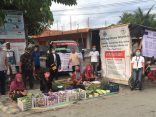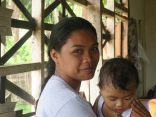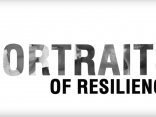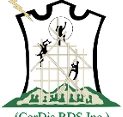by Amian Tauli
In photo: Community members of Sitio Mangagew working together to construct the distributor tank for their water system (Amian Tauli / CorDis RDS)
Ti daga ket biag. Land is life. This quote is a truism that the indigenous people of the Cordillera have asserted time and again as they struggled to develop and live in the mountainous terrain that has been their homeland since time immemorial. By living closely with their environment, they have been able to accumulate indigenous knowledge and practices that guide every aspect of their lives.
by Amian Tauli
In photo: Community members of Sitio Mangagew working together to construct the distributor tank for their water system (Amian Tauli / CorDis RDS)
Ti daga ket biag. Land is life. This quote is a truism that the indigenous people of the Cordillera have asserted time and again as they struggled to develop and live in the mountainous terrain that has been their homeland since time immemorial. By living closely with their environment, they have been able to accumulate indigenous knowledge and practices that guide every aspect of their lives. These practices and knowledge such as the appearance of a certain animal or plant, the behaviour of pets, the color of the sky and many others that signal the occurrence of a certain phenomena have also been pivotal in helping them cope with and bounce back from hazards and disasters they have faced throughout the years. However, the changing climate has made it difficult for the communities. They have struggled to apply the knowledge that has served them well for a long time. Today, very rare is the instance where the appearance of a certain migratory bird can signal the onset of strong rains or a typhoon.
Sitio Mangagew is just one of the 12 communities in the Cordillera where the Partners for Resilience (PfR) programme is being implemented. From the town proper in Bokod, Benguet, it can be reached by a two hour hike or an hour’s drive through a muddy, rutted road that is impassable during the rainy season. It is mainly inhabited by the Ibalois, one of the major ethno-linguistic groups in the Cordillera.
The community members derive their livelihood from planting rice and other vegetables majority of which are rain-fed. But recently, the community has reported a steady decline in rice and vegetable production due to the lack of rains leading to reduced water supply especially during the summer months. Based on climate projections for the region, or the years 2020 and 2050, rainy seasons will be wetter, summers will be drier and the whole year will be hotter 0.9 degrees Celsius. Climate change has also escalated the uncertainties in the communities’ agricultural production as the increased occurrence, intensity, and length of rainfall events—which consequently increase erosion rates, trigger landslides, and make certain crops susceptible to diseases—have impacted crop production in the community.
These climate projections, in combination with the indigenous knowledge and practices of the community and ecosystem information have been the starting point for the Cordillera Disaster Response and Development Services (CorDisRDS), a local partner of CARE Nederland, in implementing the PfR programme. The approach by CorDisRDS has been to supplement scientific information with local knowledge in all steps of implementation from the community risk assessment to contingency planning at the local government level in order to gain a comprehensive picture of the local situation.
The climate projections in particular have been especially important in designing small-scale mitigation (SSM) projects for the communities. SSM projects are interventions that aim to reduce vulnerabilities through strengthening, diversifying or protecting livelihoods.
For Sitio Mangagew, due to the observed decrease in water supply and long-term projection of drier summers, CorDisRDs and the community agreed to build a communal water system as their SSM. The aim of the project was to provide a steady supply of water that can be used for both irrigation and domestic purposes thereby strengthening agricultural production. After consultations and planning with the local government unit and peoples’ organization, work began. A site was carefully selected ensuring that no damage will be done to the environment. Materials were carried four kilometres and the whole community relied on their traditional practice of “gamal” or cooperative endeavour to provide labour.
Since the water source was located two kilometres away and one had to pass through a river to reach it, the plastic pipes needed to bring the water to the community were fastened to steel cables that stretched from the water source across the river to the sitio center. The community worked steadily for one month while balancing their economic activities in order to complete the project. Even the families who were not direct beneficiaries pitched in. Finally, on September 2014, the community installed the final plastic pipe. It took two months of hard work but the hope of having a steady water supply was closer to reality.
Today, the community is enjoying the benefits of their hard work. The water system is fully functional and is being used for irrigating the newly planted rice.
“We are very thankful to CorDis RDS and CARE through the PfR programme for providing us support to construct our water system. Our sitio is rarely visited by other people. At first we were hesitant to participate in the project because we had a hard time understanding the concepts being introduced. We felt that our practices were enough to protect us from disasters but we soon came to understand the importance accepting new ideas because our traditional knowledge may not be applicable all the time. ” said Victorio Agustin, a village leader, while proudly showing the completed tank full of water to be distributed to the different households.
It is always a challenge when working with a community that has a deeply-rooted belief system because they may be hesitant to accept new ideas and concepts thinking that their own traditional knowledge is sufficient. But Sitio Mangagew is an example of how the scientific data including climate projections and ecosystem data in conjunction with indigenous knowledge and practices can be effectively used to build safer and resilient communities.




